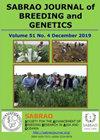玉米产量与维生素A的杂种优势及品系配合力分析
IF 1.7
Q3 PLANT SCIENCES
引用次数: 0
摘要
开发一种高产且富含维生素a原的玉米品种是减少营养不良和提高产量的最佳途径之一,特别是在以玉米为主食的地区,如刚果民主共和国的前加丹加省。但是,对产量和维生素原a的配合力和杂种优势有较好的认识。因此,对8个品系、4个试验体及其32个杂交种的产量、维生素原a含量等农艺性状进行评价,发生在2015-2016和2016-2017两季。结果表明:各F1杂交种间配合力和杂种优势相关的遗传参数对除株高外的其他性状均有影响。亲本基因型P6和P10对提高百粒重、籽粒产量、插穗高度和维生素原A含量具有较好的效果。亲本基因型P7、P4和P2在维生素原A含量方面具有优势,而亲本基因型P3在籽粒产量方面具有优势。5个组合(P10 × P5、P10 × P6、P10 × P7、P10 × P8和P11 × P5)是提高产量和维生素A原含量的最佳组合。F1杂种P10 × P6具有较好的特定配合力,是生产产量最高、维生素A原潜力最大的双、三杂种的最佳组合。杂交组合P10 × P5和P11 × P5是籽粒产量的最佳组合,而杂交组合P10 × P7和P10 × P8在维生素原A含量方面表现良好。本文的研究结果将有助于未来培育具有高产和维生素A原元素的玉米基因型的育种计划,从而缓解粮食不安全和营养不良。本文章由计算机程序翻译,如有差异,请以英文原文为准。
HETEROSIS AND LINE-BY-TESTER COMBINING ABILITY ANALYSIS FOR GRAIN YIELD AND PROVITAMIN A IN MAIZE
Developing a high-yielding and provitamin A-rich maize variety is one of the best approaches to reduce malnutrition and increase production, especially in regions where maize is a staple food, such as, the former Katanga Province in the Democratic Republic of the Congo. However, it requires a good knowledge of combining ability and heterosis for grain yield and provitamin A. Thus, evaluating grain yield, provitamin A content and other agronomic traits of eight lines, four testers, and their 32 hybrids occurred during the 2015-2016 and 2016-2017 cropping seasons. The results showed that genetic parameters related to combining ability and heterosis among various F1 hybrids influenced all the studied traits except plant height. The parental genotypes P6 and P10 were suitable for improving 100-kernel weight, grain yield, stature at ear insertion, and provitamin A content. The parental genotypes P7, P4, and P2 were promising for provitamin A content, while the parental genotype P3 was leading for grain yield. Five hybrids (P10 × P5, P10 × P6, P10 × P7, P10 × P8, and P11 × P5) showed distinction as the best specific combinations for improving productivity and provitamin A content. The F1 hybrid P10 × P6 with desirable specific combining ability revealed that it is helpful as the best combination in producing double and triple hybrids with the highest yield and provitamin A potential. Crosses P10 × P5 and P11 × P5 can serve as the best cross combinations for grain yield, while hybrids P10 × P7 and P10 × P8 showed promising for provitamin A content. The presented results could benefit future breeding programs to develop maize genotypes with high yield and provitamin A elements, alleviating food insecurity and malnutrition.
求助全文
通过发布文献求助,成功后即可免费获取论文全文。
去求助
来源期刊

Sabrao Journal of Breeding and Genetics
农林科学-奶制品与动物科学
CiteScore
1.90
自引率
50.00%
发文量
63
期刊介绍:
The SABRAO Journal of Breeding and Genetics is an international journal of plant breeding and genetics research and was first published in 1969. It is the official publication of the Society for the Advancement of Breeding Research in Asia and Oceania (SABRAO).
Its objectives are to: promote the international exchange of research information on plant breeding and genetics, by describing new research findings, or ideas of a basic or practical nature; and be a medium for the exchange of ideas and news regarding members of the Society.
The Journal gives priority to articles that are of direct relevance to plant breeders and with emphasis on the Asian region. Invited for publication are research articles, short communications, methods, reviews, commentaries, and opinion articles. Scientific contributions are refereed and edited to international standards.
The journal publishes articles for SABRAO members mainly. The Journal preferred strongly that at least one author should be a current member of the Society. Non-members may also publish in the journal.
 求助内容:
求助内容: 应助结果提醒方式:
应助结果提醒方式:


